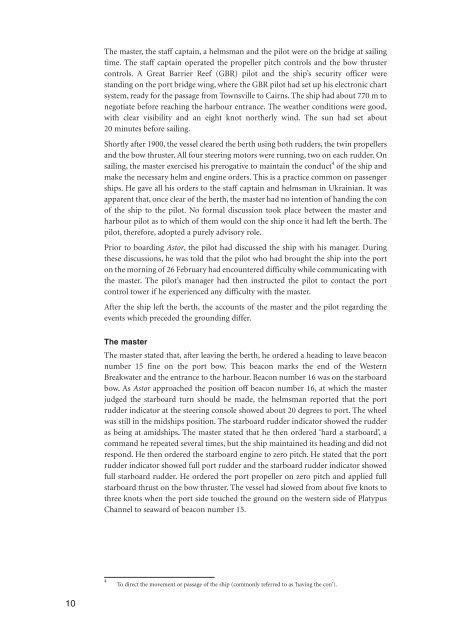MARINE SAFETY INVESTIGATION REPORT No. 200
MARINE SAFETY INVESTIGATION REPORT No. 200
MARINE SAFETY INVESTIGATION REPORT No. 200
Create successful ePaper yourself
Turn your PDF publications into a flip-book with our unique Google optimized e-Paper software.
10<br />
The master, the staff captain, a helmsman and the pilot were on the bridge at sailing<br />
time. The staff captain operated the propeller pitch controls and the bow thruster<br />
controls. A Great Barrier Reef (GBR) pilot and the ship’s security officer were<br />
standing on the port bridge wing, where the GBR pilot had set up his electronic chart<br />
system, ready for the passage from Townsville to Cairns. The ship had about 770 m to<br />
negotiate before reaching the harbour entrance. The weather conditions were good,<br />
with clear visibility and an eight knot northerly wind. The sun had set about<br />
20 minutes before sailing.<br />
Shortly after 1900, the vessel cleared the berth using both rudders, the twin propellers<br />
and the bow thruster. All four steering motors were running, two on each rudder. On<br />
sailing, the master exercised his prerogative to maintain the conduct 4 of the ship and<br />
make the necessary helm and engine orders. This is a practice common on passenger<br />
ships. He gave all his orders to the staff captain and helmsman in Ukrainian. It was<br />
apparent that, once clear of the berth, the master had no intention of handing the con<br />
of the ship to the pilot. <strong>No</strong> formal discussion took place between the master and<br />
harbour pilot as to which of them would con the ship once it had left the berth. The<br />
pilot, therefore, adopted a purely advisory role.<br />
Prior to boarding Astor, the pilot had discussed the ship with his manager. During<br />
these discussions, he was told that the pilot who had brought the ship into the port<br />
on the morning of 26 February had encountered difficulty while communicating with<br />
the master. The pilot’s manager had then instructed the pilot to contact the port<br />
control tower if he experienced any difficulty with the master.<br />
After the ship left the berth, the accounts of the master and the pilot regarding the<br />
events which preceded the grounding differ.<br />
The master<br />
The master stated that, after leaving the berth, he ordered a heading to leave beacon<br />
number 15 fine on the port bow. This beacon marks the end of the Western<br />
Breakwater and the entrance to the harbour. Beacon number 16 was on the starboard<br />
bow. As Astor approached the position off beacon number 16, at which the master<br />
judged the starboard turn should be made, the helmsman reported that the port<br />
rudder indicator at the steering console showed about 20 degrees to port. The wheel<br />
was still in the midships position. The starboard rudder indicator showed the rudder<br />
as being at amidships. The master stated that he then ordered ‘hard a starboard’, a<br />
command he repeated several times, but the ship maintained its heading and did not<br />
respond. He then ordered the starboard engine to zero pitch. He stated that the port<br />
rudder indicator showed full port rudder and the starboard rudder indicator showed<br />
full starboard rudder. He ordered the port propeller on zero pitch and applied full<br />
starboard thrust on the bow thruster. The vessel had slowed from about five knots to<br />
three knots when the port side touched the ground on the western side of Platypus<br />
Channel to seaward of beacon number 15.<br />
4<br />
To direct the movement or passage of the ship (commonly referred to as ‘having the con’).
















